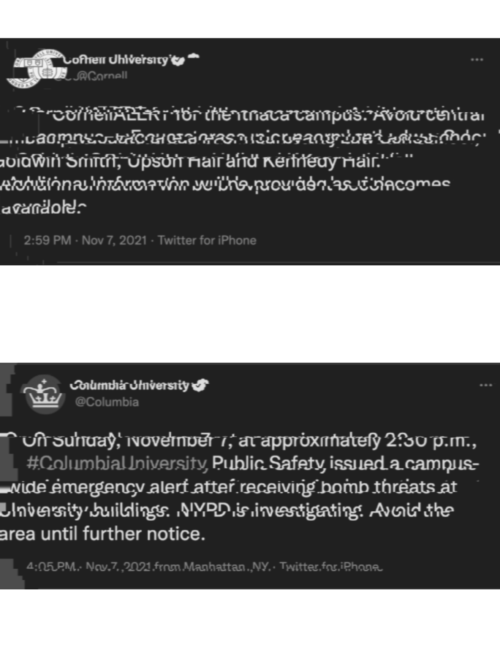You’re a First-Year at Yale. It’s a typical Friday afternoon. In between classes, you and a few friends decide to stop at Payne Whitney Gym for a quick workout. None of you are checking your school emails. Why would you? Most of the emails you receive are just fodder anyway.
Suddenly, you see a text in your group chat. A bomb threat? Before you know it, your friends on Old Campus are sending you videos of huge crowds out on the green, evacuating from dorms and academic buildings. You aren’t allowed to return to your dorm, so you pack up your gym bag and head to a secondary location where you will wait for four or five hours before the threat is cleared. You aren’t sure whether to take the threat seriously, but you decide to err on the side of caution. Maybe being at an Ivy League school makes you a target.
That was the experience of Matthew Lee, a member of Yale’s Class of 2025 on November 5th, when the University received multiple bomb threats. Several law enforcement agencies, including the FBI, responded to the threats, and students were immediately evacuated. Eventually, the all-clear was given, but not before inciting a large amount of panic and confusion in the student body. Yale was the first in a series of multiple Ivy League schools that faced bomb threats that week.
Without clear updates on the situation, students were left to speculate as to the nature of the threats. “There were a lot of different rumors floating around,” said Lee. He recalled that some students were very worried by the threats, particularly because Yale was the first school to be targeted. Others seemed to think it could have been “a pledge ritual for one of the frats or social houses on campus,” he said.
Two days later, on the afternoon of Sunday, November 7th, three more Ivies received similar threats. Cornell announced multiple evacuations, followed by Columbia,which received the threats via Twitter posts, and Brown. Major news sources started to speculate as to whether or not these threats were connected, but there is no clear answer yet.
Three more Ivies received similar threats [to Yale’s]. Cornell announced multiple evacuations, followed by Columbia, which received the threats via Twitter posts, and Brown.
Students at Brown received a text message through the Brown Alert system that read: “Brown Alert: Brown and Providence Police are investigating multiple buildings on campus involving a bomb threat. All Main Green buildings, Rock/Hay, List, Lyman.” Students were evacuated promptly, and updates were given throughout the situation until it was cleared.
Brown University student Amanda Tabet ’23 remembered sitting in her dorm room when she first learned of the threats and was not satisfied with the level of communication. “It was clear you had to evacuate the specific buildings, but they never really specified what proximity we should be relative to those specific areas,” she said. “Also, I don’t know how often people check those texts.”
Most of the Brown students Tabet knows were not too disturbed by the threats. “Generally, people didn’t really take it seriously because the way it was presented to us wasn’t that serious,” she said. One of her friends even wanted to go to one of the buildings from which students were being evacuated, but decided not to, only to avoid potential closures.
Tabet’s concerns regarding the lack of communication from administration at Brown were consistent with the sentiments of other Ivy League students, including those whose schools did not report any received threats.
A student at the University of Pennsylvania, who asked to remain anonymous for fears of retaliation by the administration, said he heard of a bomb threat not through Penn but through a Facebook group. While Penn did not report any threats as Yale, Cornell, Columbia and Brown had done, the post seemed to spark rumors around his friends.
“I never received any official communication or email acknowledging the situation,” the student said, only an article from the Daily Pennsylvanian (DP) discussing threats at other institutions. “Maybe Penn didn’t receive a bomb threat,” the Penn student admitted, but “given the fact that this is going on, specifically at multiple Ivy League institutions, it is enough for people to need to be informed directly. We don’t all read the DP.”
Students at Harvard have also not received any communication from University administration regarding the situation. It remains to be seen whether Harvard and its peer institutions will clarify the muddled information and improve their lack of communication. In the words of the Penn student, “You [the administration] are obviously aware of these threats, so why did you see them and decide it wasn’t something the student body needed to know about?”
Maddie Proctor ’25 (maddieproctor@college.harvard.edu) is tired of being left out of the loop.

